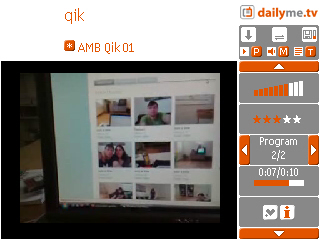When I met with Qik's VP Marketing and co-founder Bhaskar Roy, he said that they were planning to bring these videostreams also to mobile phones. "Qik is developing a new live streaming to other mobile handsets", says Bhaskar. "You won't even need a browser to watch a livestream. We send a Realvideo stream directly to your friends' cell phones." The cell phone will not only be a camera for mobile live video streams, but also a tv set to watch them. Everyone is a sender and a receiver, because Qik plans to stream its videos in 3GP format to mobile handsets.
Well, they can stop now their development or should at least consider this blog post (just kidding!): I am already able to stream my Qik live videos as 3GP videos to mobile phones. And I am not even a techie. I just did a mashup with another hot startup in mobile space: dailyme.tv from Berlin, Germany. Here you can see a screenshot, showing a Qik video on a Nokia E61:
Qik offers and RSS feed to every user's account which can be subscribed in dailyme.tv. So the Qik streams don't come as live videos to the phone, but they are fairly often updated. "The more often a video RSS feed is updated, the more often we send it to the phones", explained dailyme.tv CEO Michael Merz when we met this week. His service is basically a content aggregator for mobile phones. They bring tv shows and video podcasts into 3GP format which basically every mobile phone understands. So dailyme.tv is also a good way to watch video podcasts in weird formats which only an iPod can handle. The Symbian Freak wrote a good introduction into the service:
Screenshot from a Qik video stream on a mobile phone
The mobile phone television service, dailyME.tv, started a TV push service just in time for the CeBIT, that automatically brings video files and podcasts to subscribers's mobile phones. DailyME is the simplest way to have mobile access to premium TV content and a wide range of Videocasts. Users have the opportunity to be their own TV manager: register, program your own TV and video channel and have it updated automatically, whenever you are online with your mobile phone (WLAN, UMTS, GPRS, HSDPA).
One can choose from a wide selection of different channels and divisions, offered by the service provider. There is no live streaming and content can be downloaded over an internet connection and currently there is only client for Symbian S60 3rd edition phones. Thanks to the unique transmission technology (patent pending) on the basis of the technologies on-hand today, an individual program can be made available for mobile phone users 24 hours per day.
A fast internet connection over Wifi or 3G is necessary for dailyme.tv. GPRS could also be used, but then you should expect longer loading times. The videos have a resolution of 320 x 240 pixels, and picture quality is reasonable at 350 Kbit with 12.5 pictures per seconds. What I like most about dailyme.tv is that they are able to transcode every video format, even the *.flv Flash videos from Qik. Over Wifi it doesn't even suck much battery. From time to time the handset connects for very short to download the latest videos. A drum sound of the Devicescape software reminds me that dailyme.tv again started a download.
I can watch the videos later in idle times while commuting. "From April on we will start to offer dailyme.tv also for Windows Mobile 5 Phone edition and Windows Mobile 6.1 Professional Edition", says Michael Merz. "Then we will send our videoclips also in WMV format." I think he should also talk to Qik, which has great XML interfaces. They already offer one click integration of their videos into Twitter, Seesmic, Mogulus, Blogger, mobuzz.tv, justin.tv and Youtube. Great names, but none of them has such a cool application for mobile video.
Disclosure: I am not on a dailyme.tv payroll. I just like their service and that it comes from Germany. Qik is also a mostly Russian company, only the head office is in Silicon Valley.
